Looking for the best solution to create your first-ever eCommerce website? You are in the right place. Today, we are going to make a deep analysis of two popular eCommerce solutions- Joomla and WordPress to identify which platform could be the best option for you.
WordPress is by far the most popular eCommerce solution which was founded by Matt Mullenweg in 2003 as a blogging platform. Though initially, the main purpose of WordPress was blogging, nowadays, it’s one of the reliable go-to solutions for creating any type of eCommerce website.
Joomla, On the contrary, is another powerful Content Management System that was invented by Andrew Eddie, Brian Teeman, Johan Janssens, and Jean-Marie Simonet in 2005. Joomla has extensive support for creating eCommerce websites.
So, which platform would be the best choice for a beginner like you? Let’s check it out!
Joomla vs WordPress – A Short Overview
What is Joomla
Joomla is one of the most popular free and open-source Content Management Systems (CMS). That means you don’t have to pay for it, and lots of people work together to make it better all the time.
Joomla is good for different kinds of websites, like blogs, news sites, and also for selling things online. It’s user-friendly and has a big community, so you can find help and support if you run into trouble.
Market Share of Joomla
According to W3Techs, Joomla has a market share of 2.6% of all websites whose content management system is known, as of October 12, 2023. This is 1.8% of all websites.
This means that Joomla is the fifth most popular content management system in the world, after WordPress, Shopify, Drupal, and Wix.
What is WordPress
WordPress is the most popular free and open-source Content Management System (CMS).
It was originally created as a blogging platform, but it has evolved into a versatile CMS that can be used to create a wide variety of websites, including blogs, news, portfolios, business sites, and of course eCommerce stores- both single-store and multivendor marketplaces.
The ease of use, user-friendly interface, and little to no learning curve make this platform massively popular, especially among non-techy people.
Market Share of WordPress
As we already said, WordPress is the most popular Content Management System. According to the latest data shared by W3Techs, WordPress has a market share of 43.1% of all websites, as of October 12, 2023.
This means that WordPress powers over one-third of all websites on the internet.
If we look at only websites that are created with CMSs, WordPress’ market share is even higher: 63.1% of websites built with an identifiable content management system are currently using WordPress!
Joomla vs WordPress for eCommerce: Key Features, Similarities, and Differences
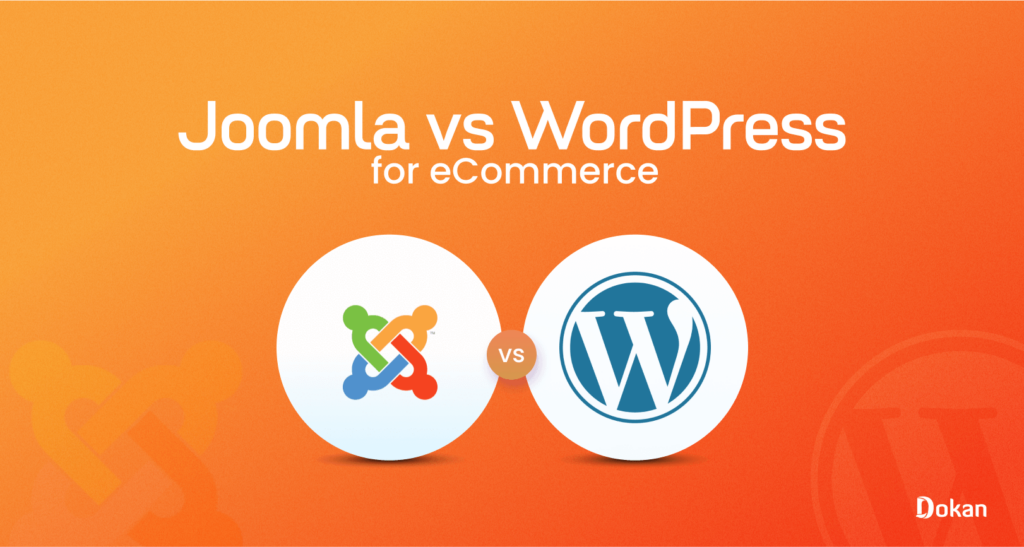
Joomla and WordPress both are Content Management Systems. So, having similarities between them is normal. That being said, they also have distinct features and behaviors in some aspects.
In this segment, we are going to make an in-depth analysis of similarities and key differences between these two most popular CMSs.
Here are the points we are going to cover-
- Interface and Ease of Use
- Design and Personalization
- Shipping
- Tax
- Payment Gateways
- Security and Backup
- Product Management
- Marketing and SEO
- Help and Support
- Pricing
Now let’s get started with the first point –
1. Interface and Ease of Use
If you are a beginner, the first thing that you need to figure out is which platform has the lowest learning curve and is easy to use. In this part, we will show you the ease of use and interface of both CMSs from a beginner’s perspective.
Joomla Interface and Ease of Use
Joomla is a self-hosted platform which means you have to buy domain and hosting upfront to install Joomla on your cPanel. Installing Joomla is almost similar to installing WordPress. However, many hosting providers provide a one-click installation package to make this process further easier.
After installing the Joomla, the dashboard may seem a bit overwhelming to you, especially if you are using it for the very first time. It will surely take a significant time to get used to the Joomla backend dashboard.
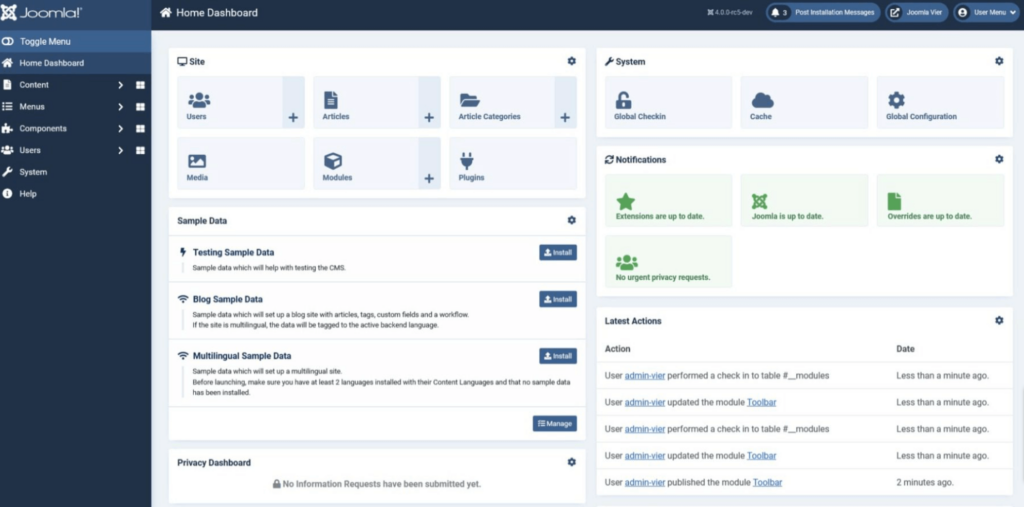
Joomla’s admin panel does have a quick-menu sidebar to the left, like WordPress. But most of the features and utilities live on the top menu, and you access those via dropdown. Also, you can’t click a new menu item until you’ve closed the current one.
To get started with the eCommerce shop using Joomla, you’ll have to install an eCommerce extension like VirtueMart, HikaShop, etc.
WordPress Interface and Ease of Use
Like Joomla, WordPress is also a self-hosted platform. After buying a domain and hosting, you can easily install WordPress on your cPanel in 10 minutes. You’ll get a clean slate after installing the WordPress.
Unlike Joomla, WordPress comes with a very easy user interface. Even if you have no prior experience with web development, you should be able to figure out how to use WordPress quickly and easily.
If you want to create any post, page, or media, you’ll get everything on the left sidebar.
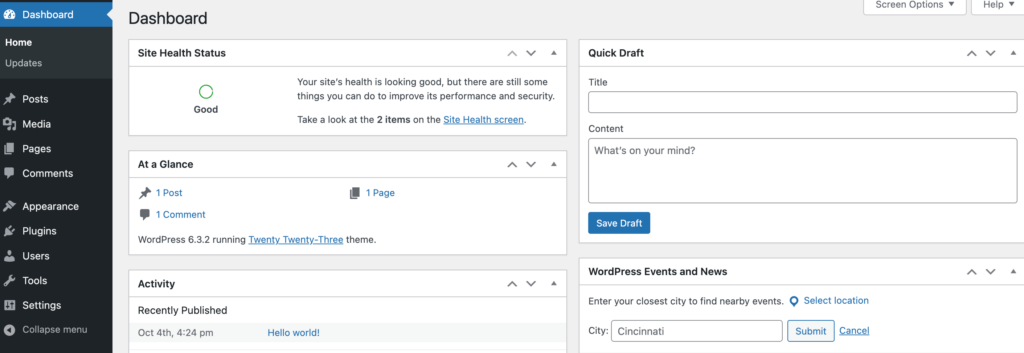
WordPress, by default, doesn’t come with any eCommerce features. So, to create an eCommerce store with WordPress, you have to install a free plugin called WooCommerce. This plugin has all the features to easily create and manage any kind of eCommerce store.
2. Design and Personalization
Your website needs to reflect your thoughts and philosophy. To do so, you need to have full freedom while designing your website. WordPress and Joomla both come with different themes, plugins, and extensions to make the designing process easier for you.
Let’s discuss about that:
Design and Personalization Features for Joomla
a) Templates
- Joomla provides a range of templates that control the overall design and layout of your website.
- There are both free and premium templates available in the Joomla Extensions Directory and from third-party sources.
- Templates often come with customization options that allow you to adjust colors, fonts, and layouts to match your brand.
b) Extensions
- Joomla offers a vast collection of extensions, which are like plugins in WordPress. These can significantly extend the functionality and design of your website.
- You can find extensions in the Joomla Extensions Directory (JED) and from third-party developers.
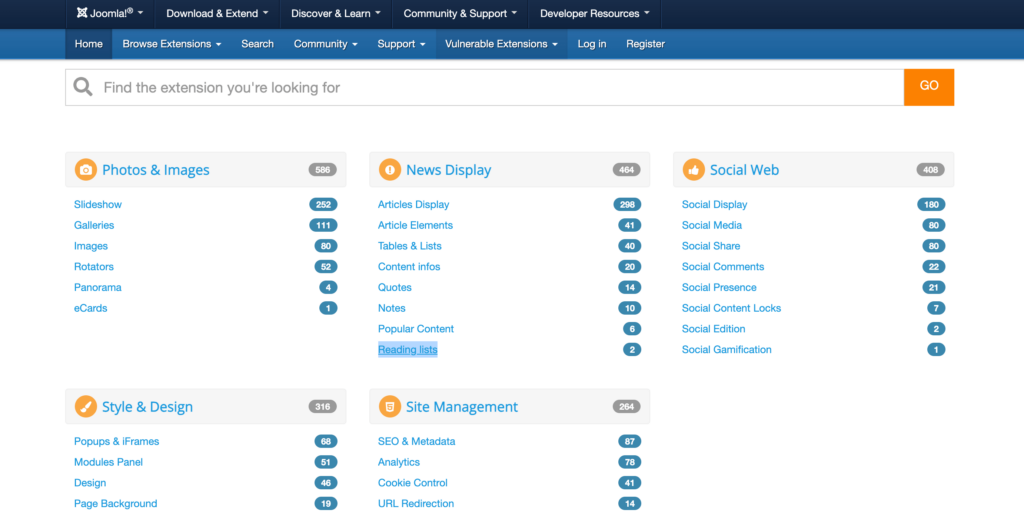
c) Custom CSS
- Joomla allows you to add custom CSS styles to your template, which enables you to fine-tune the design and appearance of your site.
d) Page Builder Extensions
- Some Joomla extensions, like SP Page Builder and Quix, function as page builders and offer drag-and-drop interfaces for creating custom layouts without coding.
Design and Personalization Features for WordPress
a) Themes
- WordPress offers a vast library of themes, both free and premium, that control the overall look and layout of your site.
- In the WordPress repository, you will find 2200+ free themes for eCommerce stores.
- You can easily switch between themes, and most come with customization options for colors, fonts, and layout, allowing you to align your site’s appearance with your brand.

b) Plugins
- WordPress has more than 60,000 free plugins in the repository. And this number is only getting larger every day. Also, WordPress has a numerous number of third-party premium plugins available for you.
- For implementing eCommerce features like store SEO, payment gateway, shipping, product preview, etc., you will get several plugins for each purpose in the repository.
c) Page Builders
- Page builder plugins like Elementor, Divi, and Beaver Builder empower you to create custom layouts with a user-friendly, drag-and-drop interface.
- These tools often include pre-designed content modules that simplify the process of adding various elements to your pages.
d) Custom CSS
- If you have coding knowledge, you can add custom CSS styles to fine-tune your site’s design and appearance.
e) Widgets
- WordPress offers a range of widgets that you can place in widget-ready areas on your site. These widgets can display content like recent posts, categories, and more.
3. Shipping
When you are creating an eCommerce website, shipping is one of the most crucial aspects that you need to figure out to keep your customers satisfied.
Both Joomla and WordPress come with a foolproof shipping facility. But both have different approaches and offerings. Let’s check them out:
Shipping Facility for Joomla
- Shipping Extensions: Joomla offers various shipping extensions that you can integrate into your eCommerce site. These extensions provide features for configuring and managing shipping options.
- Shipping Methods: You can set up different shipping methods, such as standard shipping, express shipping, or local pickup. These methods can be based on factors like weight, destination, or product type.
- Shipping Zones: Joomla allows you to define shipping zones, which are geographical regions where you offer shipping services. You can specify different shipping rates and methods for each zone.
- Shipping Calculators: Shipping extensions often include calculators that automatically calculate shipping costs based on the customer’s location and the items in their cart. This helps customers know their shipping fees during the checkout process.
- Shipping Rules: You can set up specific shipping rules, like offering free shipping for orders over a certain amount or providing discounts for loyal customers.
Shipping Facility for WordPress
- eCommerce Plugins: To enable shipping features on your WordPress website, you’ll typically use eCommerce plugins such as WooCommerce, Easy Digital Downloads, or WP eCommerce. These plugins offer comprehensive shipping solutions.
- Shipping Methods: eCommerce plugins provide a range of shipping methods to choose from, including standard shipping, express shipping, local pickup, and more. You can configure and customize these methods based on your specific business needs.

- Shipping Zones: You can define shipping zones, which are geographical regions where you offer shipping services. Each zone can have its own shipping methods, rates, and rules. This allows you to tailor shipping options to different locations.
- Shipping Calculators: eCommerce plugins often include shipping calculators that automatically determine shipping costs based on factors like package weight, destination, and shipping method. This provides real-time cost estimates during the checkout process.
- Shipping Rules and Discounts: You can set up rules and discounts related to shipping, such as offering free shipping for orders over a certain amount or applying discounts for loyal customers.
- Notifications and Tracking: You can set up automated notifications to keep customers informed about their order’s shipping status, including tracking information and estimated delivery dates.
4. Tax
Tax calculation is complicated. It will take your lots of time and effort if you want to do it manually. So, you should rely on your chosen eCommerce platform to handle this job.
Let’s find out which platform offers what support to handle tax automatically!
Joomla Tax Feature
- Taxation Extensions: Joomla offers a variety of tax-related extensions that can be integrated into your website to manage tax calculations, rates, and compliance.
- Tax Calculation: Joomla tax extensions typically allow you to configure tax rates based on factors such as your location, your customer’s location, the type of product or service being sold, and any relevant tax laws or regulations.
- Tax Rules and Regulations: You can set up specific tax rules and regulations, such as determining which products or services are taxable and which are exempt.
WordPress Tax Feature
- eCommerce Plugin: WooCommerce is a free, highly flexible eCommerce plugin for WordPress that provides robust features for managing taxes.
- Tax Configuration: Once WooCommerce is installed and activated, you can configure tax settings from the plugin’s settings in the WordPress dashboard. You can specify your business’s location and address to set up tax rates accordingly.
- Tax Zones and Classes: WooCommerce allows you to create tax zones, which are geographical regions where you’ll apply taxes. You can define different tax classes based on the type of products you sell, such as standard, reduced, or exempt.
- Tax Rates: Within each tax zone, you can set up different tax rates based on local tax laws or regulations. WooCommerce lets you create both standard and reduced tax rates as needed.
- Tax Calculation Options: You can choose to apply taxes based on the customer’s shipping address, billing address, or your store’s base location, ensuring accurate tax calculations during the checkout process.
5. Payment Gateways
Payment gateways in an eCommerce store securely process online payments. It plays a crucial role by encrypting payment information, authorizing transactions, and ensuring secure communication between the customer’s bank, the merchant, and the payment processor.
Payment Gateways for Joomla
Joomla’s dedicated eCommerce solution is called VirtueMart. VirtueMart offers integration with a wide array of prominent payment gateways, allowing you to provide a versatile and secure payment experience for your customers.
Among the notable payment gateways supported by VirtueMart are PayPal, Stripe, Wirecard, Google Pay, and Apple Pay.
With VirtueMart, you can configure your eCommerce website to accept a range of payment methods, giving you the flexibility to cater to various customer preferences:
- Credit cards and debit cards
- PayPal, Stripe, and other international payment methods
- Cash on delivery, and
- Direct back transfer.
Payment Gateways for WordPress
WooCommerce is the dedicated eCommerce solution for WordPress. It has integration with all the major payment gateways, including PayPal, Stripe, Wirecard, Google Pay, Apple Pay, etc. You can install the WooCommerce Payments plugin to accept credit cards, debit cards, and other popular payment methods.
You can also configure WooCommerce to accept the following payment methods:
- Check payments
- Cash on delivery
- Direct bank transfer
- Local payment methods, such as Boleto Bancário, Paytm, and Alipay
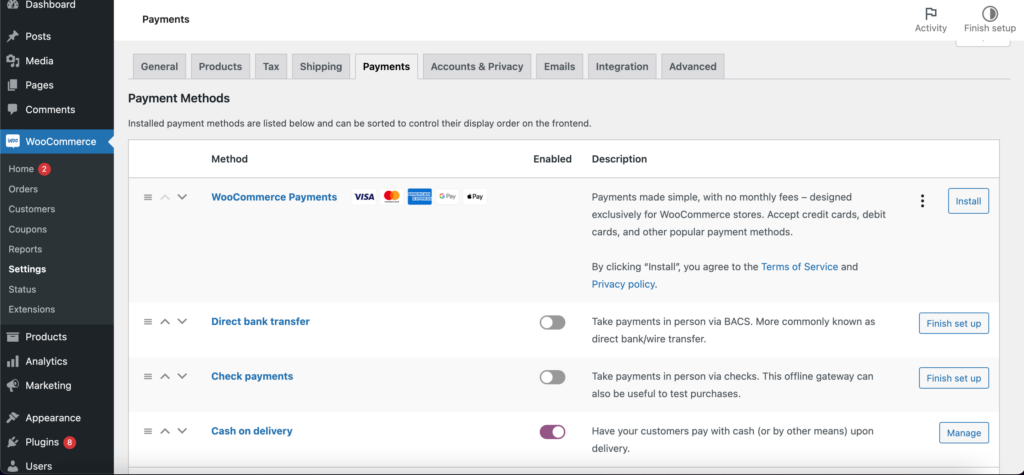
To configure WooCommerce to accept these payment methods, you will need to install and activate the appropriate extensions. For example, to accept check payments, you will need to install and activate the WooCommerce Checks extension.
6. Security and Backup
Security is a big concern for any website, no matter if it’s an eCommerce store or a portfolio website. If you can’t guarantee the privacy of your customers’ sensitive data, customers won’t visit your store again.
So, before choosing a platform for creating your eCommerce store, make sure you have done good research on that platform, especially the security part.
Joomla Security and Backup
Joomla focuses on security with regular updates to address vulnerabilities. It provides User Access Control, Two-Factor Authentication, and CAPTCHA integration. Users can bolster security with third-party extensions like Akeeba Admin Tools and RSFirewall!
Joomla enables manual backups through the admin panel and recommends Akeeba Backup for automated backups. To secure backup data, users can set up remote storage options. These practices and tools enhance website security and data protection.
WordPress Security and Backup
WordPress has the largest number of users among all the CMS platforms. Since it has the most users, the possibility of attacks is higher here. WordPress itself is a secure platform, however, the problem arises when someone uses third-party plugins or themes from untrustable sources.
To tighten the security of your WordPress-powered eCommerce store, you have to use a security plugin like Wordfence, Sucuri, Security Ninja, etc.
Since WordPress doesn’t offer any built-in backup service, you have to install a backup plugin like UpdraftPlus, BlogVault, Duplicator, etc. to ensure automatic backup for your eCommerce site.
You should also regularly update your WordPress core version, plugins, and themes to secure your website from any unwanted threats.
7. Product Management
Product management includes the feature that every platform offers to add, edit, and delete products. Since it’s an eCommerce platform, you need to have the flexibility to add different kinds of products like physical, downloadable, virtual, and variable products with different sizes and colors.
So, in this segment, we will analyze which platform gives you the most flexibility in terms of product management.
Product Management for Joomla
- Product Creation: Joomla offers an easy way to create product listings with detailed information, including descriptions, images, and pricing. This makes it easy to present your products effectively to customers.
- Customization: Custom Fields are a valuable feature in Joomla, allowing you to add specific attributes to your products. Whether it’s size, color, SKU, or other details, you can customize products to meet your exact needs.
- Categories and Tags: Joomla’s category and tagging system makes it simple to structure your product catalog, helping customers navigate your website seamlessly.
- Inventory Management: Joomla enables you to monitor product availability and set up notifications for low inventory. More advanced inventory management features are available through third-party extensions.
- Image and Gallery: Product Images and Galleries are essential for showcasing your products. Joomla supports various image upload options and gallery features to create visually appealing product displays.
Product Management for WordPress
- Product Creation: WooCommerce- an eCommerce solution for WordPress, makes it super easy to add, edit, and delete any products to your eCommerce store. It enables you to create detailed product listings, including product descriptions, images, pricing, and variations.
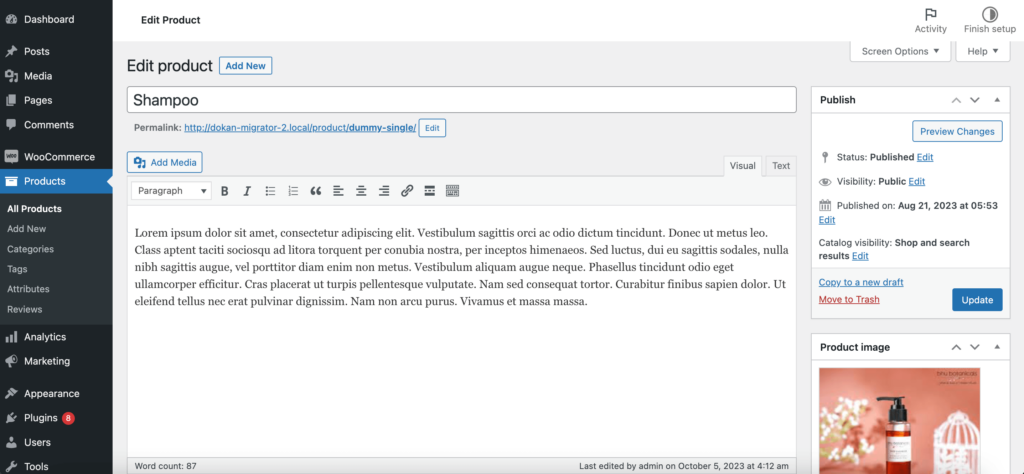
- Customization: You can customize products with various attributes, including size, color, SKU, and more. This flexibility allows you to cater to different product types and variations.
- Categories and Tags: Organize your products by categorizing them and adding tags for easy navigation. This enhances the user experience, helping customers find products quickly.
- Inventory Management: Keep track of your product stock levels, receive low-stock notifications, and manage inventory efficiently. Various inventory management features are available through WooCommerce and other eCommerce plugins.
- Product Images and Galleries: WordPress provides excellent support for product images and galleries. You can showcase your products with high-quality images and create appealing product displays for your online store.
8. Marketing and SEO
After creating an eCommerce store, you need to let people know about it, right? That’s where marketing and SEO comes in. You should put effort behind marketing and SEO so that you can reach your target audience.
To do that, you need to get some support from your chosen eCommerce platform. Joomla and WordPress both platform offer marketing and SEO features. Let’s check which platform comes with the most convenient features for you!
Marketing and SEO for Joomla
- Built-in Features: Joomla provides an array of built-in SEO features, making it easier to optimize your website for search engines. You can customize meta tags, URLs, and other SEO elements to improve your site’s visibility in search results.
- Blogging: Joomla’s content management capabilities allow you to create and organize blogs for effective marketing. You can create articles, blogs, landing pages, and more to engage your audience and improve SEO.
- Social Media Integration: Joomla allows you to integrate social media platforms seamlessly. You can share content, add social sharing buttons, and engage with your audience on various social networks.
- Email Marketing: Joomla supports email marketing efforts through various extensions. You can build email lists, send newsletters, and create targeted email campaigns to promote products or services.
- SEO Extensions: Joomla’s Extensions Directory offers a wide range of SEO extensions, such as SH404SEF and JoomSEF, which further enhance SEO capabilities by managing URLs, redirects, and optimizing site structure.
Marketing and SEO for WordPress
- Built-in Features: WordPress doesn’t offer any built-in features for marketing and SEO except permalink settings. But there are several free plugins to get this job done.
- SEO Optimization: WordPress offers powerful SEO capabilities. You can customize meta tags, URLs, and other SEO elements, enhancing your website’s visibility in search engine results. Popular SEO plugins like Yoast SEO and All in One SEO Pack provide these features.
- Blogging: WordPress is renowned for its blogging feature. You can easily create and organize content, including articles, blog posts, landing pages, and more, allowing you to effectively engage your audience and improve SEO.
- Social Media Integration: WordPress seamlessly integrates with social media platforms. You can share content, add social sharing buttons, and engage with your audience on various social networks, extending your reach and increasing brand visibility.
- Email Marketing: WordPress supports email marketing through plugins like Mailchimp, Constant Contact, etc. These tools allow you to build email lists, send newsletters, and run targeted email campaigns to promote products or services effectively.
- SEO Plugins: WordPress has a vast collection of SEO plugins. In addition to Yoast SEO and All in One SEO Pack, you can explore plugins like Rank Math and SEOPress, which offer advanced SEO features and enhancements.

Subscribe to
Dokan blog
9. Help and Support
Everyone needs support while they are building an eCommerce website, it doesn’t matter if you are a beginner or a veteran.
So, when you need help, your chosen eCommerce platform should come forward to help you out, right? Let’s check the help and support for Joomla and WordPress!
Help and Support for Joomla
Joomla does not offer direct support such as email ticketing or WhatsApp messaging for free users. However, there are a number of ways that free Joomla users can get support:
- Joomla documentation: The Joomla documentation is a comprehensive resource that covers all aspects of Joomla, from installation to configuration to development.
- Joomla forums: The Joomla forums are a great place to ask questions and get help from other Joomla users.
- Joomla community: The Joomla community is very active and helpful. You can find Joomla support on a variety of social media platforms, such as Facebook, Twitter, and LinkedIn.
Help and Support for WordPress
Like Joomla, WordPress also doesn’t provide any direct support like email ticketing, or WhatsApp messaging. But you can get answers to your every query through its community, official documents, and forums. Since it has the largest user base, so you won’t feel alone whenever you need any help.
- Official WordPress.org Support Forums: WordPress.org hosts an active support forum where users can ask questions, seek help, and share their experiences. The forum is a valuable resource for free users, and you can usually find solutions to common issues and answers to your questions.
- Official WordPress Documentation: The WordPress Codex and official documentation provide a wealth of information. They cover a wide range of topics related to WordPress usage, configuration, themes, plugins, and more. These resources are freely accessible and can help you troubleshoot issues and learn more about WordPress.
- WordPress Community: WordPress has a vibrant and helpful community of users and developers. You can connect with other WordPress enthusiasts on various social media platforms and join user groups for support, advice, and discussions.
- Plugin and Theme Support: If you encounter issues with specific plugins or themes, you can often seek support through the official WordPress Plugin and Theme directories. Many developers provide support forums for their products, even for free versions.
- WordPress Meetups: WordPress Meetup groups often organize local and virtual events where users can meet, share experiences, and seek help. Check for meetups in your area or attend virtual meetups to connect with other users.
10. Pricing
Pricing is always a concern for every eCommerce startup owner. Before choosing a platform for creating your eCommerce store, you must check the pricing of your chosen platform.
Joomla Pricing
Joomla is an open-source content management system (CMS), which means that the core software is available for free.
You can download and use Joomla without any licensing costs. This makes it an attractive option for those who prefer a free and open-source platform for building eCommerce websites.
WordPress Pricing
Like Joomla, WordPress is also an open-source and free content management system. So, you don’t have to pay any fee to use this platform to create your eCommerce websites.
Cost of Creating an eCommerce Site Using Joomla and WordPress
In this segment, we are going to give you an estimated budget to create a basic eCommerce website using Joomla and WordPress.
| Joomla | WordPress | |
|---|---|---|
| Platform Fee | Free | Free |
| Domain | Between $5 to $10 per year | Between $5 to $10 per year |
| Hosting | Between $200 to $250 per year | Between $200 to $250 per year |
| Development and Customization | Between $1500 to $3000 | Between $1500 to $5000 |
| eCommerce extensions | Between $0 to $500 | Between $0 to $500 |

Comparison Table of Joomla vs WordPress for eCommerce
Below is a comparison table of Joomla and WordPress based on the specified entities:
| Criteria | Joomla | WordPress |
|---|---|---|
| Ease of Use | Relatively complex | Very user-friendly |
| Cost | Open source (free) | Open source (free) |
| eCommerce Features | Good for online stores | Requires plugins/extensions |
| SEO | SEO-friendly but requires effort | SEO-friendly with plugins |
| Security | Solid security but may require third-party extensions | Secure platform, but you need to make sure you’re using authentic plugins and themes. |
| Support | Community-driven support and professional services | Community-driven support and professional services |
| Blogging | Suitable for blogging but not the primary focus | Excellent for blogging |
| Multilingual | Multilingual capabilities with extensions | Multilingual support out of the box |
| Developer Tools | Robust development tools | Extensive development resources |
| Good For | Complex websites, portals, and online stores | Blogs, portfolio, eCommerce, and small to medium-sized businesses |
| Limitations | Learning curve, not as user-friendly | May require additional plugins for advanced functionality |
| Multivendor Support | Supports multivendor eCommerce with extensions | Supports multivendor eCommerce with plugins |
Which Platform Is Better for eCommerce- Joomla vs WordPress?
Both Joomla and WordPress are powerful, free, and open-source platforms for creating eCommerce websites. Here are our findings for you:
Reasons to Choose Joomla Over WordPress:
- More flexible and customizable
- Better product management
- Better shipping and payment options
- Enhanced security
Reasons to Choose WordPress Over Joomla:
- Ease of use
- Larger community and developer base
- More pre-built eCommerce solutions
- Lower costs
- Content and marketing
- SEO-Friendly
That’s all from our side. Now it’s your turn to choose the most suitable platform as per your requirements. Don’t forget to let us know which platform you are choosing using the comment box below.
Check our other popular comparison posts on WordPress vs different eCommerce platforms-
Subscribe to
Dokan blog
We send weekly newsletters, no spam for sure!

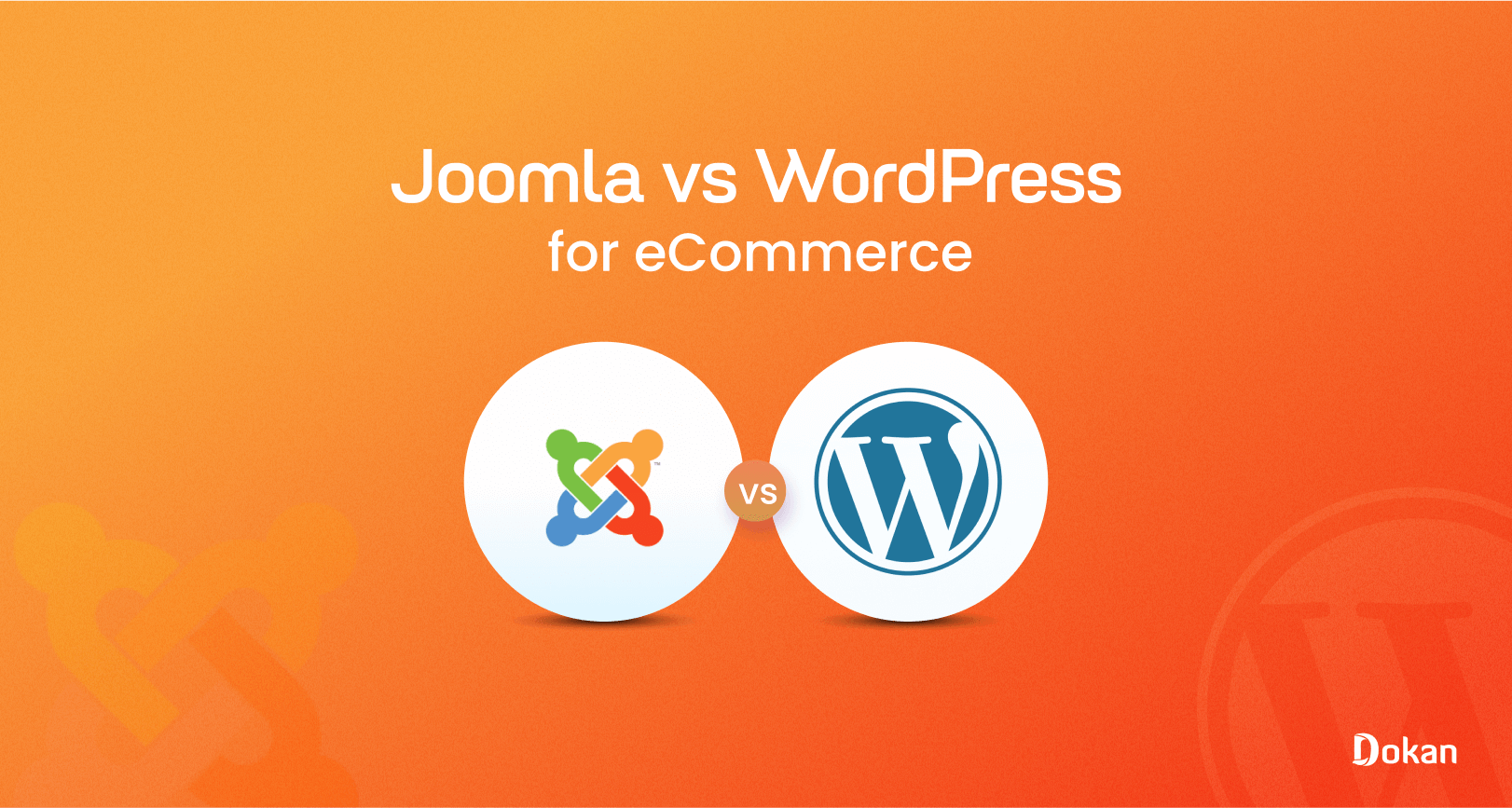





Leave a Reply